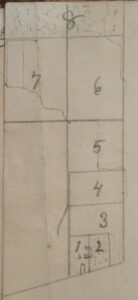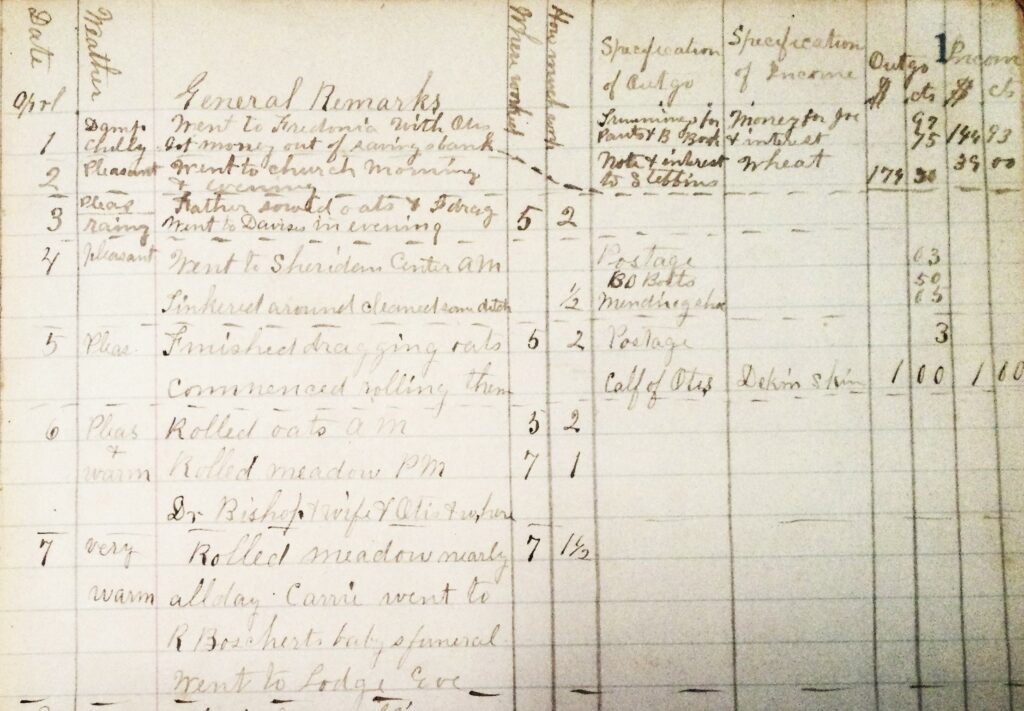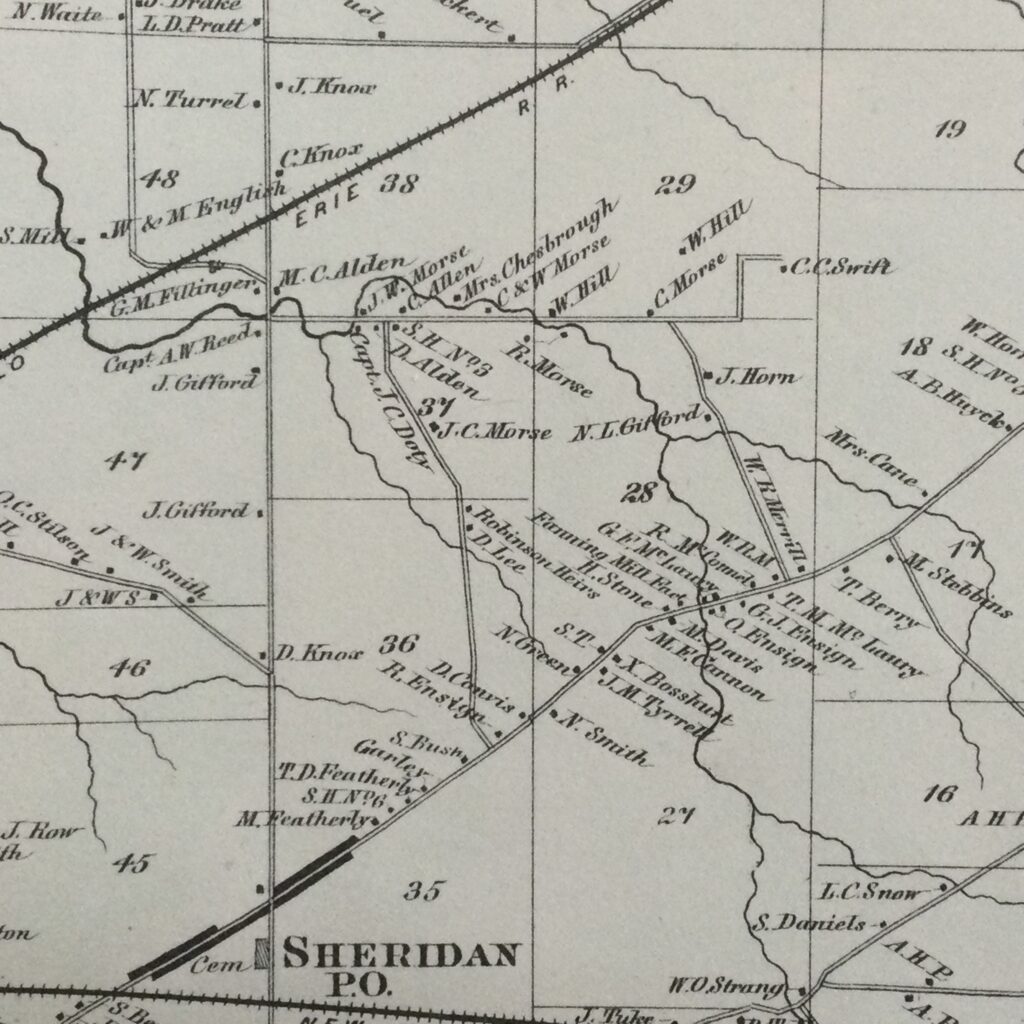A Peek Into early 1870s Sheridan
By Virginia T. Becker
How quickly a power outage can shock us back to the 1800s! How dependent we, in the 21st century, have become on electric lights and automatic heat – not to mention cable TV, internet, and phones. Lack of access to the outside world hits home with the realization that your emergency cell phone isn’t charged. So, when the power poles and cables just west of Sheridan Center toppled in 70 mph gusts, I traveled back to 1871 by necessity, and with curiosity.
Rather than tune to the news of the day, I lit two candles to explore an 1871-1873 journal kept by George E. McLaury, a former Sheridan resident. Two candles seemed fitting for this endeavor. My mother used to talk about how her father used one candle to read most of his print material. But when the Saturday Evening Post arrived, two were lit. Also, I was well aware that George McLaury likely recorded his thoughts by candle or kerosene lamp light. What follows is a glimpse of what my candle glow revealed about life in Sheridan at that time, along with additional background on this journal keeper.

George Everell McLaury (1838–1919) was a farmer best known in local history as supervisor for the town of Sheridan from 1898 to 1904. He was the son of Thomas Moore (1815-1879) and Hannah L. (1815-1867) McLaury. Eleven-year-old George appears in the 1850 federal census with his family in the town of Evans, N.Y. He arrived in Sheridan with his father in 1858 and remained in town, except for his time spent in Ohio during the Civil War. He and Carrie (Caroline) Eliza Jackson (1838–1916) were married August 27, 1860, and were enumerated in Sheridan in the 1865 New York State census. A map of Sheridan in The New Topographical Atlas of Chautauqua County, New York, 1867 indicates that George owned property on the north side of U.S. Route 20, a little west of what was known as Merrill Road in Lot 28. His father owned property in Lot 27 on the south side, across from Merrill Road. By 1881, it appears that they had switched properties, possibly in 1871; on April 1, 1871 he declared in the forward to his journal how he came to said property:
Have hired of Father his share of this place consisting of 26 acres together with his share of stock which consists of 3 ½ cows and heifers value about $170 – 2 calves value about $20 – 8 ½ sheep value about $25. for which I am to pay him $150 per annum & all taxes & if there is fruit he is to have what apples he wants to use
This note was followed by a further inventory of tools:
List of Farming tools & other personal property owned by me at present time as near as I can remember: 1 mowing machine, 1 plow, 1 Horse hoe, ½ Hay rack, ½ Double harness, 1 Single harness, 1 Single buggy, 1 Barn shovel, 1 ditching shovel, Hay fork (2 tines), 1 Hoe, 1 wool press, ½ each of the three horses & colts named Jim, Dick & Fanny.
He also stated he had only one large debt: “I owe $200 to Marcus Stebbins.”

In an upper corner of the first page, George plotted out his property into sections, giving each a number – one through eight. Presumably, these sections referenced fields where specific crops were planted, along with his household garden.
McLaury was a steady journalist, starting out determinedly with a column for the weather and one entitled “General Remarks” followed by columns noting where he did his work, how long he worked, and “Specifications of Outgo and Income.” The general remarks revolved around how he spent his day, where he went, who he did business with or who came to visit. For example, on April 10, 1871, he wrote:
a little cooler, sprinkled some PM Rolled two acres plowed ground for Mrs. Hart Got stone for horse block AM Sold oats to Mr. Haskins. S. Morse changed 10 bu. oats for seed – plowed garden
The subsequent columns indicate that the garden was in Sector One on his map and he worked there for a quarter of an hour. Further, he purchased 10 pounds of catfish for $.70 and sold the oats for $6.40. Though well-intentioned, sector notations gradually decreased, as seen in this entry from early 1873:
January 7, 1873: Went to the woods to work – came home at 3 PM & found Dr. Bishop & wife & Alice Shelley & Ed McCreary
Other entries illustrate how neighbors helped each other in these and other farm tasks as time from their own farms allowed. Throughout the journal we see that George labored for his father and his neighbors as well as himself, sometimes for payment and other times in kind. Both he and Carrie were willing to lend a hand:
October 11, 1871: pleasant AM raining PM Helped McConnell thresh all day Eve [Evening] Carrie went to S. Morses to sit up with Mrs. Morse who has a baby about 36 hours old.
Most of George’s days were spent in seasonal farm work. Journal entries include crops of corn, oats, potatoes, hay, wheat, and clover. All of these individually needed his attention throughout the year, requiring the preparing of the soil, planting, cultivating, and harvesting for market or personal use. The horses George shared with his father helped him with fieldwork and travel. There was apple picking and cider making in the fall. He kept hogs, chickens, sheep for wool, and cows that produced milk for butter or cheese. George delivered milk to the factory near Beaver Creek. He attended cheese factory meetings and was elected chairman at one meeting. He also had a wood lot where trees were cut for lumber and fuel. Much of the off season was spent in drawing and sawing wood.
The corn crop in 1871 started on May 10 by preparing the field, planting corn and “dragging on corn ground.” By May 26 the “corn was nicely up.” On June 1 cultivation began and on June 16 George was “plastering the corn” which meant putting hydrated lime on the silk once the ears formed to keep the worms out. By July 1 some tassels appeared. On August 21 the corn was cut and the barn was filled by September 30. Husking commenced on October 3 and, on October 11, the stalks were put up. Eventually some of the corn was taken to the mill in Silver Creek.
A few days in July 1872 give an impression of the clover and hay harvest:
1st – Carried milk drove Fan [Fannie the horse] Mowed two acres of clover Raked part of it 2nd – Got in my clover 3rd – Cut 1 acre of clover in upper field & raked it up at night Eve [Evening] went to Brays to party 4th – Did not go anywhere Made some ice cream for Su Ensign Eve went to M. J. Tookes & got basket of cherries Eve Kate Hart here 5th – Cut a little clover & stirred out some that had got wet Went to Fredonia Carrie with me Eve went to Lodge on foot 6th – Worked at hay all day 7th – Went to church morn Children’s meeting Eve J. M. Bray preached 8th – Finished cutting my grass Cultivated some PM & raked up my hay Charley Andrews came 9th – Got in my hay Charley helped me PM Charley & I went to Lake Charley took cars [Erie Railroad] at center 6 PM Helped My [Myron] Davis get in some hay
On September 26, 1872, the McLaury farm was ready for the thresher, though it didn’t arrive until dinner time. They got 66 bushels of wheat and 15 bushels of oats. It rained all day the following day, so no threshing took place. But threshing moved nearby to Otis Ensign’s property on September 28 to continue.
November and December saw the butchering of hogs, young heifers, and an occasional sheep with participants receiving portions of the meat, as indicated in this entry:
November 25, 1872: Helped My Davis butcher D Carpenter D Convis & My Davis and myself killed 6 Went to Center after Su Aunt Becky here
Holidays seemed to pass quietly, though some witnessed unrelated events. July 4, 1871 brought a rained-out picnic, though folks later came to see “the little boys have their bon fire and fire balls.” On May 30, 1872, George quietly mentions going “to Fredonia for grave decoration.” Christmas 1871 had elements of both the expected and unexpected:
December 24,1871: Went to church Carrie heard M Bray Eve went to church heard Bray talk some & 25 S School scholars repeat as many verses
December 25, 1871: Christmas Tinkered some Johnny Pattersons horses ran with him from the Center to Chesbros before he could stop them Peter Frye came and took Belle to Silver Creek to take the cars for Angola
December 26, 1871: Went to town to see Grand Duke Alexis of Russia went on foot The train which he was on did not stop causing disappointment to a great many people Got a ride to Center with Grant Griswold from there to Rilys [sic] with Sam Patterson Eve Carrie went to see Aunt Hannah [The Grand Duke was traveling around the country and was passing through on his way from Buffalo to Cleveland.]
Christmas 1872, meanwhile, passed amid news of horrible tragedy in the town of Portland. At least 20 people were killed on Christmas Eve when a passenger train went off the trestle at Prospect Station and the cars erupted into flames. George recorded the following:
December 24, 1872: Very cold & Stormy – awful accident today at Prospect Station on Crosscut RR 26 killed Went to Silver Creek PM

In January 1872, there were big doings in the county that George attended:
January 16, 1872: Chored around some getting ready to go to Nashville Father drew home his straw Eve Carrie & I went to church (paid preacher $6.00) [Chores appear to be the daily tending of his animals or seeing to things around the house as specifics are rarely mentioned about those duties.]
January 17, 1872: Got up early Took it afoot to Forestville Took 8 o’clock train Billy Ensign got train to stop at Turners bridge to let me off [William Ensign was a railroad brakeman and George’s next door neighbor.] Walked from there to Nashville Joined convention Saw Mrs. Norman Brown Staid all night at Nevins (RR fare $.25, conference ticket $.50, candy $.05)
January 18, 1872: Attended convention all day Eve staid all night at Nevins
January 19, 1872: Attended convention all day Walked to Smiths Mills & took train to Sheridan Center Staid to Lodge Came home found folks abed Ambrose Cash & wife here (RR fare $.20)
 As there were no refrigerators in the 1870s, ice was an important commodity for preservation:
As there were no refrigerators in the 1870s, ice was an important commodity for preservation:
January 23, 1872: Rigged up wagon & went to cheese factory to get ice Drew two loads before dinner Came home and found Uncle A D Jackson & daughter Drew one load of ice just [sic] night
January 24, 1872: Drew two loads of ice which was all the house would hold Eve went to church
Throughout these years, George McLaury was a faithful worshipper, attending choir practice on Saturday evenings and church, sometimes twice, on Sundays. Only severe weather or illness kept him at bay. He attended the Methodist Episcopal Church at Sheridan Center which had its beginnings about 1808 and its first structure built in 1833-34. Several different preachers were mentioned in the journal, but J.M. Bray and E.D. McCreary appear frequently.
George speaks often about “Lodge” which seems to be in reference to the Good Templars in Sheridan. In one post he got the Good Templar mail, in another he arrived at the Good Templar Hall [possibly Tooke’s Hall that eventually became the Sheridan Grange] to help prepare it for an event, and in a third he attended the G. T. Lodge and Festival. Other entries on this topic include:
November 24, 1871: Husked some Eve went to Lodge Debated with Bray on question of Resolved that the present license system is a detriment to temperance.
February 2, 1872: Went to woods about noon & worked until about 3 o’clock Eve went to Center to Good Templars was installed W. C. T.
February 19, 1872: Worked around the house until noon PM went to Republican caucus Eve Went to Fredonia with Bray to Public installation I. O. of G. T.
A separate source states that George McLaury was a member of the Independent Order of Odd Fellows (I.O.O.F.) Were some of his lodge meetings for this organization?
George was active in civic and political endeavors. He was a Republican and cast his first vote for Abraham Lincoln in 1860. Besides his terms as town supervisor, George served the community in other ways. In the Gazetteer and Directory of Chautauqua County, N.Y. for 1873-74, George’s father Thomas is listed as a town assessor. It appears George assisted him, then took over that role for many years. Several journal entries talk of assessing properties and meeting with the other assessors. About 1899, he became a justice of the peace.
At the Sheridan centennial celebration on August 31, 1904, in his last year as Supervisor, George gave one of several speeches commemorating the early settlement on the Collins property. It began:
We meet today to glance over the course along which the past century has come to us. The fruitage of a full hundred years has been gathered into God’s great storehouse.
The full speech and other details of this event can be found in the Sheridan section of The Centennial History of Chautauqua County, Volume II (1904).
George wrote several other essays in his day. Though his journal was concise, his way with words in essays reflected his educational background. He attended school at Eden Center, Forestville, the Fredonia Academy, and Evandale Academy of Angola. He attained a teaching certificate in 1875 and taught in a district school some winters. In August of 1871, George wrote an essay for the “Harvest Home” picnic. A few days later he consulted Dr. Bishop “for criticism on the essay.” He also noted an essay he wrote for Sunday School on the life of Joseph.

Community events received more ink than regular daily activities:
July 11, 1871: warm & sunny Went with milk rained hard PM went to George Morses bot hog ($8) & then to S. Center to law suit between road corn & Beman Butler.
July 26, 1871: pleasant Went on to Baldwins hill to see about place to hold picnic Elder Bray and WR Miner with me Concluded to hold picnic there PM went to Silver Creek to get my horse shod Carrie went to Albert Stebbins Came back & took supper at Abs
August 16, 1871: Went to picnic at Baldwins Grove rode with band from Forestville My [Myron] Davis took my team & carried ice cream & Harry Shelley to grounds I read essay on Harvest home S. Clark of S Creek spoke also Prof Peate & Bro Bray Had ice cream saloon to pay expenses of band Worked in it all day Came home tired and dusty
August 20, 1871: Went to north woods & fought fire nearly all day It came near to catching on Philip Browns house We wet roof & wind changed a little so we saved it Fire burning in Micah Englishs & also on Pattersons wood job
March 15, 1872: Went down in the north woods to see about RR accident Accommodation train off the track Engine & Baggage car in the ditch & nobody killed and only Fireman & Engineer not Brakeman on wricking [sic] train killed last night. Watched them getting cars on track until 2 o’clock & then came home Eve went to Lodge on foot Rode home with Marvin Morse [An accommodation train is one that stops at all or nearly all stations.]
At this time people traveled on foot, by horse, horse and buggy or wagon, or train. George recorded his travel expenses as a matter of course. Often, neighbors would give each other a ride. George would report that someone would ride back with him from meetings or he with them.
On September 21, 1871 George went to the Fair (ticket $.50), took notes for the Chautauqua Farmer, later wrote up the notes, and then took them to the Farmer office in Forestville. In October, George also attended an international fair in Buffalo taking him three hours to get home.
As the entries below illustrate, there were celebrations and entertainment like picnics, speakers, overnight visitors, sugar parties, and concerts when the weather cooperated.
September 5, 1871: pleasant Went to Charlotte with Otis [Ensign] and wife to Kate Hart’s picnic Started at 8 AM got back 6 ½ PM
February 8,1872: Worked in woods PM AM tinkered bob sleighs Eve went to concert at Fredonia Su Ensign & Kate Hart with us After concert went to Abe Tunkeys they gave us some refreshments Got home about midnight The Concert was given by Co convention (concert $1.00) [Abram Tunkey was a blacksmith in Fredonia.]
February 13, 1872: Went to Center to get my boots tapped Otis with me could not get them done Eve started to go to concert at Fredonia but when we got to Rush Miners it stormed so we turned around and came back to Convisses & staid part of eve [It stormed for two days following.]
At the end of March 1872, George summarized his year in his “Outgo and Income” columns:
Household expenses including charity & leisure about $160.00 Had on the whole a poor season Stand just about as I did one year ago Whole amount sold for year about $425.00
Occasionally, George would become introspective for a moment as noted in these two entries:
August 27, 1872: My Birthday Can it be possible that I am 34 years old today May my future days be spent in a better manner than those that are past – Plowed nearly all day with Fannie.
April 1,1873: Two years have passed since I commenced keeping this diary How swift time flies May each passing year only serve to make me better prepared for Eternity Got 200 dollars from Kate Hart to pay Marcus Stebbins – split some wood Mr & Mrs Stebbins here Eve
George paid off his “one large debt” in two years. He also paid rent to his father as money came in, sometimes in cash and other times in product as in this example:
April 30,1872: I finished planting my potatoes Fathers garden Turned yearlings into woods (rent $75 – 1 ½ in potatoes)
Deaths, births, marriages, and sickness were recorded. Among the funerals George noted were: Mrs. Caroline Edmunds, Amelia Eldred, Mr. McBride, Uncle Tyler Featherly, Ed Tuttle (he and George Durfee were killed by inhaling gas while digging a well), Minerva Baldwin, Leroy Perkins (killed on railroad), Uncle Bill Griswold, Mrs. Albert Homan, Jack Davis, Mrs. McConnell and Mrs. Van Schoonhoven. The graves of several of these folks can be found in the Sheridan Center Cemetery. Some of the family surnames can also be seen in period atlases showing the location of family residences.

On August 2, 1872, George entered this simple statement at the end of his entry: “ Marlow hung today.” Charles Marlow was a brewer in Jamestown, NY who was accused of killing William Bachmann. Details surrounding this incident can be found at https://www.murderbygaslight.com/2013/11/the-marlow-murder.html. It was an event that marked the times.
On a more pleasant note, George wrote of the birth of his daughter in what follows. (This blessed event and the plans leading up to it were nearly missed. Two candles were not the enough when reading faded 150-year-old ink and inadvertently skipping a page.)
February 8, 1873: Went to Rush Miners to get Lydia to see Amanda Carrier about working for us as Su [Ensign] is about to get married PM went to Silver Creek with Su Could not get Amanda so I engaged Nett Baldwin. [Nett commenced work on February 10]
March 5, 1873: Went to Su Ensigns wedding She was married to H Miner by Rev. McCreary & then left for Falls
March 16, 1873: Took Mrs. Johnson home very cold & windy. Nett went home & staid nearly all day Eve Carrie taken sick Went after Dr. Bishop at Silver Creek at 9 o’clock & got back about 11 Old Mrs. McConnell died today
March 17, 1873: Carrie sick – little girl baby born at 3 o’clock AM – staid in house all day PM went to Forestville after Aunt Rebecca
The next three days George “staid around the house.” The baby was named Emma, but in all entries following her birth she is referred to as “baby.” Emma E. McLaury (1873–1944) in time was to be known as Elsie. She married Almon Louis Cook (1872–1945) and together they had three children: Everell A., Elsie, and Rachel. Rachel (1908–1984) married William Hohenstein (1908–1989) and they had three children: William, Shirley, and Roger.
Life events continued after the baby was born:
April 26, 1873: Plowed Nett Baldwin left
April 27, 1873: Staid home & took care of baby
June 19, 1873: Mrs Hart married today to Mr Barker
Many surnames mentioned in the document are very familiar to Sheridan: Davis, Baldwin, Merrill, Ensign, McConnell, Collins, Featherly, Patterson, Chesbro, Griswold, Johnson, Tooke, Mead, Munson, Shattuck, Carpenter, Miner, Newell, Stebbins, and Morse, to name a few.
George McLaury appears to have been a healthy man. Rarely an ailment was mentioned, though during a week of putting new shingles on his roof, he did pause for a “sick headache.”
In between major crop endeavors, George “chored around,” “tinkered up some fence,” drew wood, got horses shod and harness oiled, repaired equipment, washed sheep, “fussed with yearling,” went to the Center for mail, got a haircut, visited neighbors “of an evening” who were “plucking geese for market,” and participated in all the other minutia of daily life.
Eventually daily chores, working the farm, family responsibilities, and other obligations led to the shortening of his journal entries, as seen in the following notes from July 1873:
July 13, 1873: Baby Sick… Dr. here yesterday & today
July 14, 1873: Baby a little better Finished cultivating potatoes Fixed reaper Cut around my wheat
July 26, 1873: Rainy AM Dr came and lanced babys neck Father Jackson & Carries Uncle Holbrook here
July 27, 1873: Did not go to church on account of baby being sick
The last entry was August 17, 1873 and simply said, “Went to church in Paynes church.” August 18, 1873 was without comment.
On one page towards the back dated November 13, 1874, George drafted the beginning of a letter seeking to hire someone to teach in a district school. It was followed by lines of letters as if practicing his cursive script. At the very back was a page recording receipts and payments.
This was a serendipitous journey. It supplied a multitude of details of daily life in early 1870’s Sheridan and its people. As I blew out the candles on that dark, dark night, I no longer had to imagine what it was like for George E. McLaury, his family and neighbors to live at that time. I had taken a brief tour through the seasons of his years to appreciate his hard work and dedication. Many thanks to Roger and Romaine Hohenstein for the loan of this wonderful primary source document as well as other of their family artifacts donated to the Sheridan Historical Society.